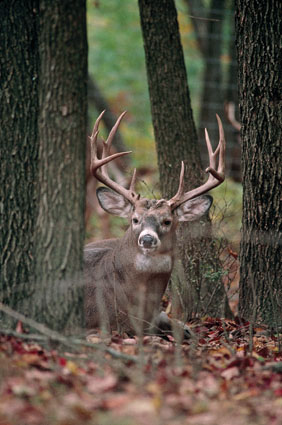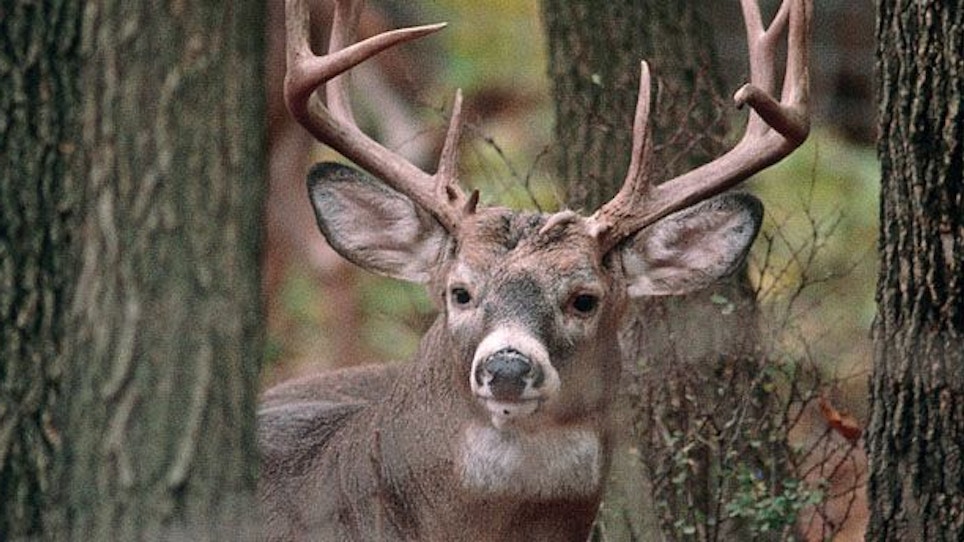 We’ve all heard this story time and again. A hunter has scouted a good buck, has his stands set, is sure he can find the monster on opening day — and then the rascal disappears. It’s times like these when you hear the common phrase, “He’s gone nocturnal.”
We’ve all heard this story time and again. A hunter has scouted a good buck, has his stands set, is sure he can find the monster on opening day — and then the rascal disappears. It’s times like these when you hear the common phrase, “He’s gone nocturnal.”
But has he really gone nocturnal, or has he just left the area? Here’s a good example of what can happen in the deer woods during the hunting season: My bowhunting friend, Dennis Crabtree from Ohio, hunted a Boone-and-Crockett buck the whole bow season in 2006. He saw him three times but never got a shot. Denny spotted the buck several times during the following summer, but come the fall of 2007, the buck was gone.
With no more sightings or trail-camera photos, Dennis began to think something happened to the buck — until early December when he got him on film again in the same spot he’d been spotted the previous year. Present in the summer, gone in the hunting season — it happens all the time.
It turns out that lots of older bucks disperse to a new area. Some stay and some return to the old area as much as one year later. One camera study done in Missouri by Dr. Grant Woods suggests that as many as half the bucks over 2½ years of age leave their home range in late September and do not return for up to a year. Woods believes that these fall movements are caused by a shift in preferred food sources. Deer move to find better food. If there is good rain and good forage, fewer bucks shift their home range, which makes hunting these old guys all the more challenging. By the way, four days after Dennis got pictures of that buck on film, he took him with his bow.
Has He Moved?
It turns out that some bucks just up and move in the early part of bow season, and others leave their home range for a while during the rut. But what about going nocturnal? Dr. Mickey Hellickson followed radio-collared bucks in Texas and found that during the rut they tend to be active all day, with activity decreasing at night. He also found that the older a buck gets, the less he moves. Of course that makes him all the harder to hunt.
One other thing. Hellickson found that some bucks move four times more than other bucks. One 6½-year-old buck was active 87 percent of the time, while an 8½-year-old buck was only active 18 percent of the time. Thus, bucks are a lot like people — there are some older guys who walk every day, climb mountains, and are just plain active, and others who sit around and watch TV a lot.
Jim Tomblinson recently completed a study in eastern Maryland showing that bucks leave their home range before and during the rut for extensive movements to areas not previously occupied. An example was a buck named“49 blue” (age 3½ years). This buck used two different areas that were 3.7 miles apart. During the summer and also from Nov. 26 to Dec 10, he used one area. But during Sept. 3-23 and Oct. 15- Nov. 25, and after Dec. 10, he used both areas. He made purposeful movements from one area to the other on three different occasions. The first was on Sept. 7, and he stayed until Sep 23; the second was on Oct. 20 and he stayed until Nov 18. His third trip to the other home range was Dec 27 to Dec 29.
Tomblinson has similar data for other bucks, and it explains why some of the older bucks you hunt disappear for a day or more — they just leave their home range for excursions into new territory. Take a look at Table 1. We can’t tell from this table how often bucks move out of their home range during each time period, we just know that they did leave.
Table 1. Percent of bucks that leave their home range for an extensive movement. These data are from 15 bucks, all over 2½ years of age.
| Dates | Percentage of bucks that move | Day Movement | Night Movement |
| Sept. 24 - Oct. 14 | 13 | 0% | 100% |
| Oct. 15 – Nov. 4 | 40 | 30% | 70% |
| Nov. 5 - Nov. 25 | 58 | 73% | 27% |
| Nov. 26 - Dec. 16 | 20 | 30% | 70% |
| Dec. 17 - Jan. 6 | 17 | Unknown | Unknown |
From this table you can see that during the rut (Nov. 5 – Nov. 25) 58 percent of the bucks left their home range at least once. Though the research did not specify how long these bucks stayed in the new area, I believe that most returned within a day. This means you can be hunting an area that you have thoroughly scouted and see a big buck that you have never seen before, and then you might never see him again. Or you can be on a big buck, having seen him three days in a row at the same area, move your stand to that spot and strike out. He might have moved out for a day and will return.
Note, as you move from the pre-rut to the rut, more and more bucks take these short-time excursions out of their home range. Then, after the rut, those percentages go down again. The second interesting bit of data here is whether these bucks move at night. In the pre-rut (Oct. 15 – Nov. 4) 70 percent of such movements are at night, but come the rut, 73 percent of such movements are during the day. So in the rut, 58 percent of older bucks move out of your area for a little while (which also means that a bunch of older bucks move into your area from their original home range), and they make many of these excursions during the day. This explains why bucks you’ve never seen pop up under your tree stand during the rut.
If there ever was information to show why you need to hunt all day during the rut, this is it. The conclusion is that there is a lot of individual variation in buck movements, but during the peak of the rut, bucks are active during the day. Add it all up and you come to realize that regardless of the reasons for buck movement, when those hot two weeks of the rut hit, you need to be out there as much as possible.






